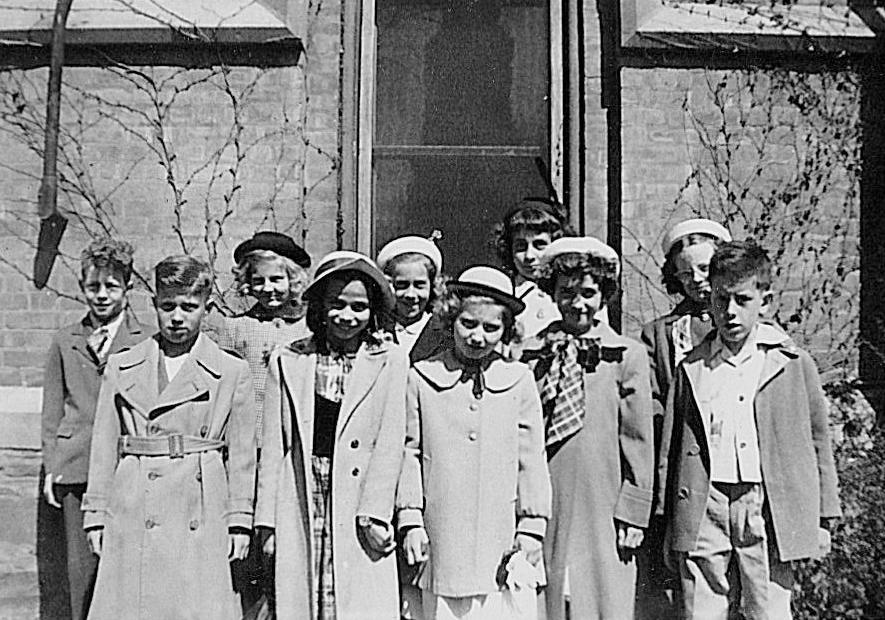
Figure 1.-- Here we see boys and girls in front of their church in the 1950s. The girls were required to cover their heads for church, but wore headwear much more commonly than boys. |

|
The principal development after World War II (1939-45) was the declining popularity of caps and hats of all kinds. We note some boys wearing adult-style fedoras when dressing up. It looks rather strange to us today, but was fairly common at the time, mostly in the early 50s. This seems rather a middle-class fashion. And it is the kast time we see boys wearing hats. Boys from upper-middle class and upper-class families more commnonly wore peaked caps when dressing up. Here there were also age conventions involved. American boys who once never left home without a cap, now commonly did so. We see boys wearing baseball caps, but they were not yet the iconic headwear that they would become. Coonskin caps became a popular fad style with the appearance of popular TV shows involving both Davy Crocket and then Daniel Boon. Baseball caps became increasingly common for casual wear. It was very important at the time how the bill was shaped. There were several different ways of doing it. Gender trends were also important. While many boys went without headwear, this was less true for girls. Girls especially when dressing up almost always wore headwear. And at the time it was vommomly hats. Girls did not wear caps, although they might wear berets. The one major exception was the winter. There was a saaonal divude. Once the weather got cold, boys did begin to wear caps. Many had ear flaps. Boys had several styles of winter caps. Girls did not wear winter caps. But both boys and girls work stocking caps and some girls wore berets. .
The principal development after World War II (1939-45) was the declining popularity of headwear, caps and hats of all kinds. We see this very clkearly in the ohotograohic record. The portrait here is a giid example. Note that mot one of the boys here has a hat or cap (figure 1). This was not so true for girls, but certainly was for boys. Headwear did not disppear, but the decloming prevalence was bery apparent. American boys who once never left home without a cap, now commonly did so
We note some boys inliding priomary-school age boys, wearing adult-style fedoras when dressing up. It looks rather strange to us today, but was fairly common at the time, mostly in the early 50s. This seems rather a middle-class fashion. And it is the last time we see boys wearing hats. Boys from upper-middle class and upper-class families more commnonly wore peaked caps when dressing up. Here there were also age conventions involved.
We see boys wearing baseball caps, but they were not yet the iconic headwear that they would become. Coonskin caps became a popular fad style with the appearance of popular TV shows involving both Davy Crocket and then Daniel Boon. Baseball caps became increasingly common for play and casual wear. It was very important at the time how the bill was shaped. There were several different ways of doing it. Boys took this very seriously.
Gender trends were also important. While many boys went without headwear, this was less true for girls. Girls especially when dressing up almost always wore headwear. You can see that here. Niruce the sharo duvude between the girls and boys. And at the time it was comonky hats. Girls did not wear caps, although they might wear berets.
The one major exception was the winter. There was a saaonal divode, especailly on really cold days. Once the weather got cold, boys did begin to wear caps. Many had ear flaps. Boys had several styles of winter caps. The most common one was a kind of baseball-styled cap dine in a heavy material. There was akso a woodsaman style, but the vaseball style was more common. Girls did not wear these winter caps. Thdy were a boys style. But both boys and girls wore stocking caps. Despite the name, stocking caps were not a true cap. A caps has a bill or peak. The term stocking cap developed in the sence of casual headwear. Some girls wore berets during the winter as you can see here (figure 1).
Navigate the Boys' Historical Clothing Web Site:
[Return to the Main U.S. headwear 20th chronology page]
[Return to the Main U.S. headwear page]
[Return to the Main U.S. country garment page]
[Introduction]
[Activities]
[Biographies]
[Chronology]
[Clothing styles]
[Countries]
[Bibliographies]
[Contributions]
[FAQs]
[Glossary]
[Images]
[Links]
[Registration]
[Tools]
[Boys' Clothing Home]
